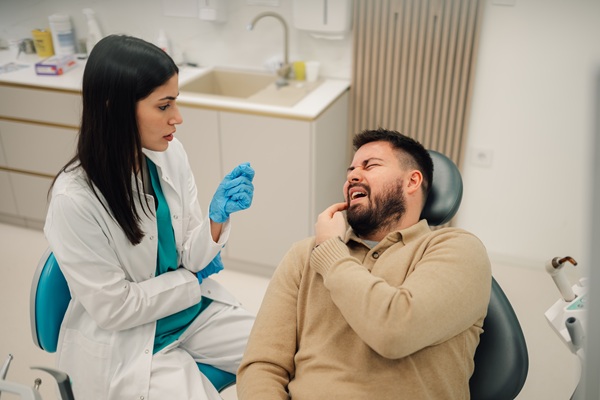3 Common Types of Jaw Surgery

Jaw surgery, formally known as orthognathic surgery, is a common procedure that an oral surgeon performs to address a range of dental and facial problems. Jaw surgery may involve manipulating the upper or lower jaw bones or both. This article will define the three most common types of jaw surgeries: maxillary ostomy, mandibular osteotomy, and maxilla-mandibular orthognathic surgery.
3 Types of Jaw Surgery
Understanding Malocclusion Classifications
While there are many reasons the oral surgeon will recommend jaw surgery, the main reason is due to severe malocclusions. Malocclusions are characterized by abnormal relationships between the teeth, jaws, and facial muscles. The word malocclusion refers to a faulty bite. They are divided into three main classes. Traditional orthodontic appliances, such as braces, can usually correct Class I. Class II malocclusions are for those who do not have enough vertical space between the upper and lower teeth due to underdevelopment in the jaw. Class III malocclusions result from a traumatic injury, undeveloped upper or lower jawbone, receding chin, or a genetic trait.
Maxillary Osteotomy
Maxillary osteotomy is a surgical procedure that repositions the maxilla (upper jaw) in order to correct an anterior crossbite or open bite. The oral surgeon will also use this procedure to correct jaw deformities such as mandibular prognathism, mandibular retrognathism, and skeletal class II malocclusions.
This jaw surgery involves the removal of bone from the upper jaw and repositioning it, lengthening it, or shortening it where needed. The surgeon will make incisions in the bones on both sides of the upper jaw and realign them into position with biocompatible titanium plates, wires, and screws.
Mandibular Osteotomy
Mandibular osteotomy is usually performed on patients who have severe facial asymmetry, who are not candidates for traditional orthodontic treatment, or who have had previous orthodontic treatment that failed to correct their malocclusion. In addition, this form of jaw surgery may help those with class III malocclusions, problems with speech or swallowing, temporomandibular joint (TMJ) disorder, sleep apnea, or facial defects noticed at birth.
The surgery involves making an incision in the gum line to access the mandible (lower jaw). The surgeon will then cut through the jawbone, realigning it to improve its position. If necessary, the surgeon will also reposition the teeth before fusing pieces of the jawbone back together with titanium plates, wires, and screws.
Maxillo-Mandibular Orthognathic Surgery (Double Jaw Surgery)
In some cases, patients may be experiencing class II and III malocclusions; therefore, the surgeon may recommend the maxillo-mandibular orthognathic procedure. It is important for patients to understand that this jaw surgery may happen in one session or multiple, depending on the patient's condition.
During the procedure, the surgeon will need to cut into both the upper and lower jaw bones to remove pieces and reposition them and the teeth or dental restorations (if applicable). The surgeon will then attach titanium plates, wires, and screws into both jawbones, remaining in place until after healing.
Schedule a consultation
Jaw surgery can be a great option for those with deformities in their jaw and those with conditions that cannot be corrected with traditional orthodontic appliances such as braces or headgear. If you need jaw surgery, contact us today to schedule a consultation.
Request an appointment here: https://www.drjstearns.com or call Platte Valley Oral Surgery at (303) 997-0220 for an appointment in our Denver office.
Recent Posts
TMJ disorders cause chronic pain and discomfort. Fortunately, an oral surgeon may perform maxillofacial surgery to treat these disorders, relieving pain and restoring mobility to the jaw. These procedures can also enhance the jaw's appearance. Find lasting comfort and improved jaw function with the help of maxillofacial surgery from an oral surgeon.These jaw disorders are…
Corrective jaw surgery is often recommended by dentists and oral surgeons to address functional problems, such as difficulty breathing or chewing, and chronic discomfort caused by a misaligned jaw or bruxism. This review discusses several important questions to ask your oral surgeon during a corrective jaw surgery consultation.Corrective jaw surgery has helped many patients feel…
Cleft lip treatment can occur early in life and set the child up for normal mouth function, including eating, speaking, and expression. A cleft lip is a condition in which an infant’s lip does not seamlessly connect; instead, a gap is present, often leading toward the nose. This congenital disability is one of the most…
A sinus lift or sinus augmentation can build up your upper jaw. This procedure is invasive. The dentist will take healthy bone and place it in the section of the maxilla that needs it. Here are the sinus lift benefits that you must consider.Studies show that a thinning upper jawbone can result in the weakening…


